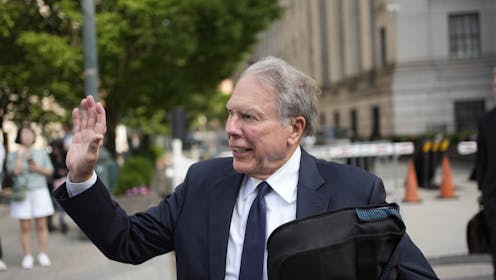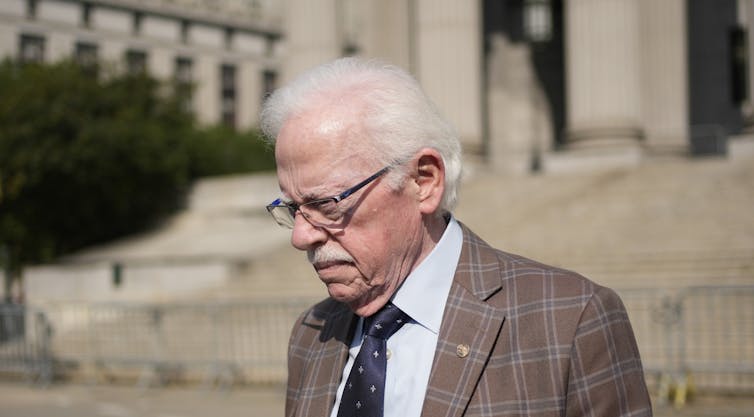
A New York judge on July 29, 2024, banned Wayne LaPierre, the former head of the National Rifle Association, from holding any paid position with the organization for a decade. The ruling came five months after a New York City jury found, during an earlier stage in these legal proceedings, that LaPierre had violated state law by misusing NRA funds. That jury also decided that LaPierre and another NRA official should repay the gun group millions of dollars.
The judge, however, rejected a request from New York state authorities to appoint an independent monitor to oversee the NRA’s use of its own assets.
The Conversation asked Elizabeth Schmidt, an expert on nonprofit accountability at UMass Amherst, what this ruling means for the NRA and its leadership.
What are the most significant aspects of this case?
The state had asked for the authority to directly monitor the NRA’s financial affairs through an appointed professional who would have reported to the court and the state attorney general. Judge Joel M. Cohen declared that this step was not necessary. Appointing someone in this capacity, he said, would be “time-consuming, disruptive and will impose significant costs on the NRA without corresponding benefits.”
The other big development is that Cohen banned LaPierre from having any role in the organization for the next decade.
LaPierre was an NRA leader for decades, and he stayed at the helm long after damaging allegations about his squandering of NRA funds came to light in 2019. In my opinion, someone who is accused of serious wrongdoing at a nonprofit should be placed on leave while an investigation takes place, and they should be out as soon as possible if that wrongdoing has been verified.
By saying the group requires a “clear break from past practices” and that LaPierre will spend at least 10 years outside its leadership, Cohen has tried to make sure that the NRA’s former CEO won’t claw his way back in.
This can potentially give the NRA a fresh start.
What challenges lie ahead for the NRA’s new leaders?
LaPierre, who is 74, had so many people within the NRA who were loyal to him that this ruling won’t make a difference unless the group does what’s required for good governance.
Among other things, Cohen has said that the NRA would benefit from having a smaller board. The gun group’s board has 76 members, and that’s way too big, according to nonprofit governance experts.
When boards are much smaller than that, there’s more of a sense of ownership and the board is better at its main job: oversight. Having as many board members as the NRA does is inherently unwieldy. I find that it’s best for no more than about 20, or perhaps 25, people to serve on a nonprofit board.
In all likelihood, the NRA’s bylaws also need to change. Currently, they make it very hard for new board members who don’t agree with a majority of current board members to be elected.
The judge is trying to shake up the organization so that it’s not as susceptible to the dominance of one corrupt person – which is what happened under LaPierre, who finally resigned in early 2024.
What the NRA’s old leaders did was so egregious and the changes were so slow that I think it could have been reasonable for the judge to order the state to directly monitor its finances. But there’s a danger in doing that with a group dedicated, to a degree, to free expression. It might have seemed like an intrusion on the freedom of speech.
To Cohen, appointing a monitor might have looked like a “speech-chilling government intrusion on the affairs of the organization,” NPR reported.
The politics of this are hard. The NRA is less powerful than it used to be, and having the government overseeing it might have backfired by rallying its members to its defense.
However, it’s not clear to me how the judge’s recommendations for NRA’s governance, aside from banning LaPierre, can be enforced.
And there’s another complication: There are reports of internal discord and a tug of war within the NRA among its new leaders, especially NRA President Bob Barr and the group’s new CEO, Doug Hamlin.

How common are outside monitors?
The monitors are incredibly rare, even in high-profile cases, because these kinds of lawsuits are unusual. That’s partly because most nonprofits fix their problems after clear evidence of legal violations arise.
Nonprofits are supposed to be self-governing. I believe that the vast majority of them are operating honestly. And when they don’t, the threat of legal action usually makes them straighten out.
Another reason why this kind of lawsuit is uncommon is the expense. This litigation, which reportedly cost the group more than US$180 million, has been an outrageous waste of the NRA’s money that could have been used to advance its core mission of protecting gun rights had it reached a settlement with New York state authorities years ago.
Is this over?
I think the NRA is happy with this ruling, since it won’t have to deal with a monitor.
“This is a major step toward rebuilding the trust of the members, donors, industry, and our staff,” Hamlin said in a statement.
And I believe that New York Attorney General Letitia James is satisfied too. In her own statement, she suggested as much, saying: “After years of corruption, the NRA and its senior leaders are finally being held accountable.”
In my view, James has actually done a favor for the NRA by getting the courts to order that money LaPierre and other top officials spent inappropriately be returned and that the group improve its governance.
Everyone has a right to appeal, of course. But because both sides can see enough victory in this ruling, it’s reasonable to assume that this particular legal battle is finally ending.
Elizabeth Schmidt does not work for, consult, own shares in or receive funding from any company or organization that would benefit from this article, and has disclosed no relevant affiliations beyond their academic appointment.
This article was originally published on The Conversation. Read the original article.







